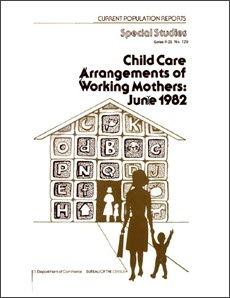Child Care Arrangements of Working Mothers: June 1982
Child Care Arrangements of Working Mothers: June 1982
Introduction
Increasing numbers of women with pre-school-age children have entered the labor force during the last several years. In June 1982, 6 million women 18 to 44 years old with a child under 5 years old were in the civilian labor force. This represents an addition of 1.3 million women with young children to the labor force since Jun 1977. How the young children of working women are cared for while their mothers are at work in not only an important issue for the social development of children, but is a paramount concern of parents, employers, and policy makers whose responsibilities include the welfare of children.
This report uses data from the June 1982 Current Population Survey (CPS) and updates a previous Census Bureau study on the child care arrangements used by working mothers, which was based on data collected in the June 1977 CPS. The ensuing analysis focuses on the current child care arrangements used by working women 18 to 44 years old with pre-school-age children, the methods of payment for child care services, and the ways that the availability of child care arrangements influence the mother’s labor force behavior.
The principal findings of this analysis include the following:
- In June 1982, 15 percent of employed mothers used group care services as a principal child care arrangement for their youngest child under 5 years old, an increase from 13 percent in June 1977.
- Employed mothers who were more likely to use group care services included Black women, women whose youngest child was at least 3 years old, well-educated women, and women working full time.
- Child care provided by either the mother or father was used by 23 percent of employed mothers in June 1982: 14 percent of the families used the father as the principal caretaker, while in another 9 percent the mother cared for the child herself while she was working.
- Among husbands who were the principal caretakers of the child while their wives worked, 71 percent were employed, 24 percent were unemployed, and the remaining 5 percent were not in the labor force.
- Seventeen percent of the care for the youngest pre-school-age child of employed mothers in June 1982 was provided by the child’s grandparent, while another 12 percent was provided by other relatives of the child. Among unmarried mothers, 40 percent of the care was provided by either the child’s grandparent or another relative.
- Approximately 17 percent of all employed mothers used more than one type of child care arrangement for the youngest child under 5 years old. When the principal type of care was provided by the father in the child’s home, 28 percent of the women used multiple care arrangements.
- Seventy-three percent of employed mothers made a cash-only payment for child care services; 94 percent of those using group care as the primary type of care made a cash-only payment.
- Among mothers of young children and who were not in the labor force in June 1982, 36 percent with family incomes under $15,000 responded that they would look for work if child care were available at a reasonable cost, compared with 13 percent of those with incomes of $25,000 or more.
A Note on Language
Census statistics date back to 1790 and reflect the growth and change of the United States. Past census reports contain some terms that today’s readers may consider obsolete and inappropriate. As part of our goal to be open and transparent with the public, we are improving access to all Census Bureau original publications and statistics, which serve as a guide to the nation's history.
Others in Series
Publication
Publication
Publication






